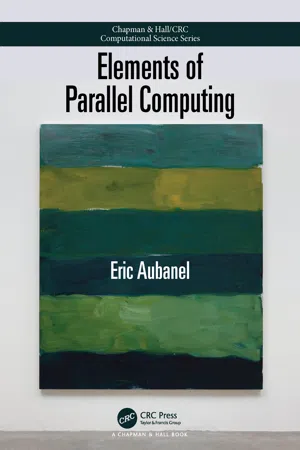Elements of Parallel Computing
About this book
Designed for introductory parallel computing courses at the advanced undergraduate or beginning graduate level, Elements of Parallel Computing presents the fundamental concepts of parallel computing not from the point of view of hardware, but from a more abstract view of algorithmic and implementation patterns. The aim is to facilitate the teaching of parallel programming by surveying some key algorithmic structures and programming models, together with an abstract representation of the underlying hardware. The presentation is friendly and informal. The content of the book is language neutral, using pseudocode that represents common programming language models.
The first five chapters present core concepts in parallel computing. SIMD, shared memory, and distributed memory machine models are covered, along with a brief discussion of what their execution models look like. The book also discusses decomposition as a fundamental activity in parallel algorithmic design, starting with a naive example, and continuing with a discussion of some key algorithmic structures. Important programming models are presented in depth, as well as important concepts of performance analysis, including work-depth analysis of task graphs, communication analysis of distributed memory algorithms, key performance metrics, and a discussion of barriers to obtaining good performance.
The second part of the book presents three case studies that reinforce the concepts of the earlier chapters. One feature of these chapters is to contrast different solutions to the same problem, using select problems that aren't discussed frequently in parallel computing textbooks. They include the Single Source Shortest Path Problem, the Eikonal equation, and a classical computational geometry problem: computation of the two-dimensional convex hull. After presenting the problem and sequential algorithms, each chapter first discusses the sources of parallelism then surveys parallel algorithms.
Frequently asked questions
- Essential is ideal for learners and professionals who enjoy exploring a wide range of subjects. Access the Essential Library with 800,000+ trusted titles and best-sellers across business, personal growth, and the humanities. Includes unlimited reading time and Standard Read Aloud voice.
- Complete: Perfect for advanced learners and researchers needing full, unrestricted access. Unlock 1.4M+ books across hundreds of subjects, including academic and specialized titles. The Complete Plan also includes advanced features like Premium Read Aloud and Research Assistant.
Please note we cannot support devices running on iOS 13 and Android 7 or earlier. Learn more about using the app.
Information
Table of contents
- Cover
- Half Title
- Title Page
- Copyright Page
- Contents
- CHAPTER 1 Overview of Parallel Computing
- CHAPTER 2 Parallel Machine and Execution Models
- CHAPTER 3 Parallel Algorithmic Structures
- CHAPTER 4 Parallel Program Structures
- CHAPTER 5 Performance Analysis and Optimization
- CHAPTER 6 Single Source Shortest Path
- CHAPTER 7 The Eikonal Equation
- CHAPTER 8 Planar Convex Hull
- Bibliography
- Index
